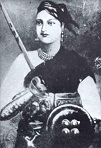18 June 1858
Death of the Rani of Jhansi
What happened?

The Rani of Jhansi, Rani Laxmibai, died on 18th June 1858 while fighting the British at Gwalior. She was a pivotal figure of the 1857 Indian Revolt. After her martyrdom, she continued to be an inspiring figure in the Indian freedom movement. Today, she is a symbol of national pride and woman power. In this edition of ‘This Day in History’, you can read all about her heroic life and sacrifice for the motherland, as part of the IAS exam history and India’s freedom struggle segments.
Rani of Jhansi
- Rani Laxmibai was born Manikarnika Tambe in a Marathi family in Varanasi on November 19th, 1835. Her parents were Bhagirathi Bai and Moropant Tambe. Morapant was working in Bithoor in the Peshwa’s court.
- She was a relative of Nana Sahib, the adopted son of the exiled Peshwa Baji Rao II. Rani Laxmibai had Nana Sahib and Tatya Tope as her childhood friends. Her education was taken care of by the Peshwa who ensured that she was also trained in shooting, fencing and horse riding.
- When she turned 7, Manikarnika Tambe was married to Gangadhar Rao, who was the King of Jhansi. She was renamed Laxmibai after marriage.
- In 1851, they had a boy who was named Damodar Rao. But he passed away after 4 months. The Rani’s husband also died in 1853. A day before he passed on, Gangadhar Rao adopted a relative’s son Anand Rao (later named Damodar Rao) in the presence of a British official. The official was also given a letter stating that Jhansi’s government was to be entrusted to his widow and that his adopted son should be provided with all due respect.
- However, Lord Dalhousie implemented the Doctrine of Lapse and staked a claim on the territories of Jhansi.
- In 1854, the Rani was presented with a yearly pension of Rs.60000 and told to vacate the palace and fort.
- When the 1857 Revolt began in Meerut, Jhansi was fairly calm. The Rani raised a body of soldiers for her own protection after taking permission from the British agent.
Read more on the Revolt of 1857: Military factors
- In June that year, the rebels seized the Fort at Jhansi and slaughtered about 40 European officers along with their families. The sepoys also extracted a lot of money from the Rani, having threatened to blow up her palace. Even at this point, the Rani was not keen on engaging in a fight with the British.
- From this time on until January 1858, Jhansi was peaceful under the rule of Laxmibai. In the meantime, she had also established a foundry in Jhansi to cast cannons to be utilised in defence of the fort.
- In March 1858, British forces under Hugh Rose arrived and found the city well-defended. He demanded a surrender of the city and warned of destroying the place if the demand was not met.
- The Rani, however, did not buckle under pressure and declared that she will fight for independence.
- Rose started the city’s bombardment on 24th March. They met with heavy gun fire. The combat continued for two weeks. Despite valiant fighting which involved civilians also, the battle was lost by Jhansi. The Rani then, tying her infant on her back, bolted to Kalpi on horseback.
- After this, the Fort of Gwalior was captured by the Rani, along with Tatya Tope and some other rebels.
- After the capture of the Gwalior Fort, she advanced to Morar in Gwalior.
- On June 17th, 1858, a British squadron led by Captain Heneage, found a large Indian force directed by the Rani at Kotah-ki-Serai in Gwalior.
- A fierce encounter ensued between the British and Indian forces. The Rani donned a sawar’s uniform and fought courageously. About 5000 Indian soldiers were killed.
- Rani Laxmibai died while fighting in Gwalior on 18th June 1858, aged 23. She was dressed as a soldier when she died.
- Gwalior was captured by the British three days later.
- According to Hugh Rose, the Rani of Jhansi was “the most dangerous of all Indian leaders.”
- In ‘History of the Indian Mutiny’, published in 1878, Colonel Malleson writes, “…she lived and died for her country, We cannot forget her contribution for India.”
- For later nationalists in the freedom movement, Rani Laxmibai turned into a symbol of resistance and bravery. She is remembered today as a great patriot who sacrificed her life fighting for her country and justice.
Also on this day
1887: Birth of Anugrah Narain Singh, freedom fighter and later politician; known as ‘Bihar Vibhuti’.
See previous ‘This Day in History’ here.
Related Links:

Comments